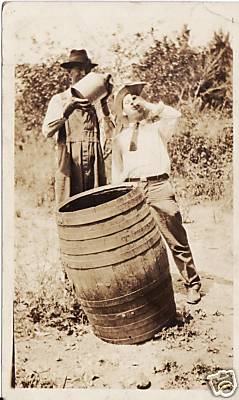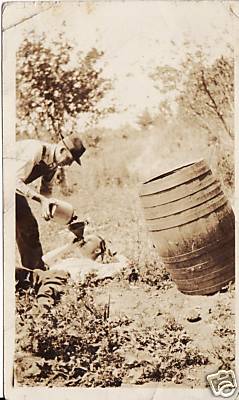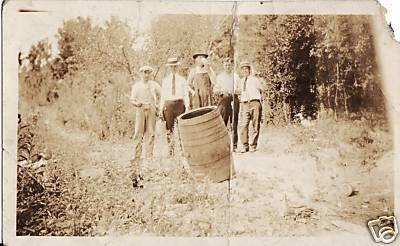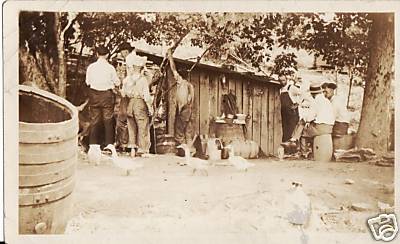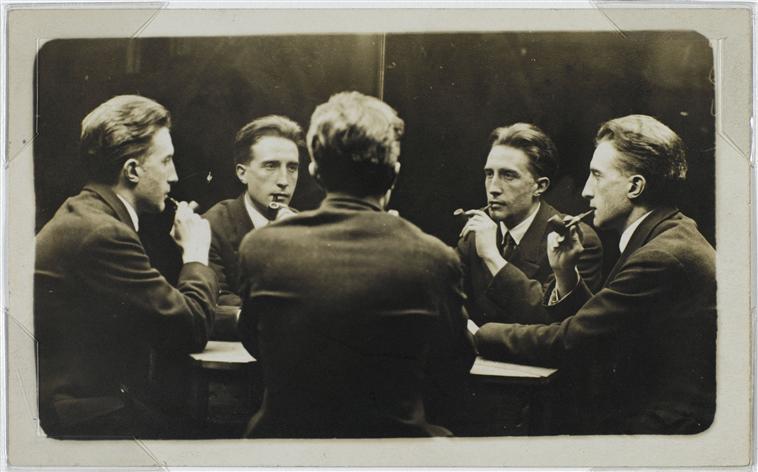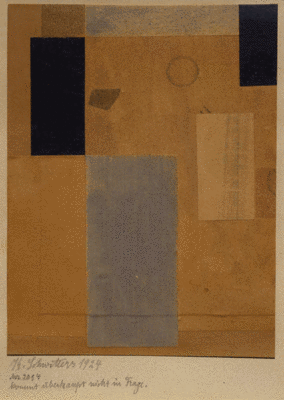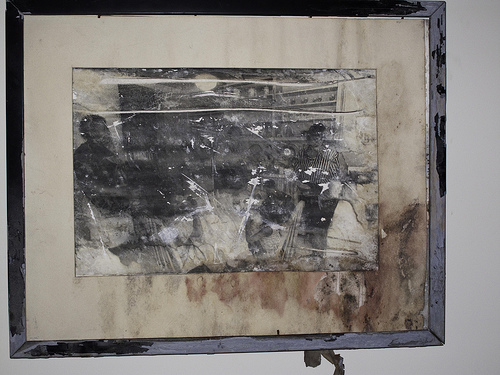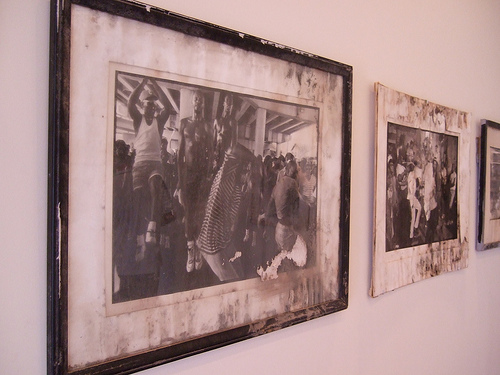Schwarz
View current page
...more recent posts
what you get for 150k (will most likely have a wood burning stove)
?!
Like the Moondance Diner before it, another New York icon has been forsaken by New York and found love in another country.Kim's collection of videos is going to Sicily.thx lisa
sifting sands of time and the danish light house
thx lisa
black paintings
fallout shelter handbook
When news emerged that a Mark Rothko exhibition was planned for Tate Modern this autumn, my heart soared. Rothko is one of the Brobdignagians of modern art, a gripping painter of big moments of transcendental abstraction. When it turned out that the Rothko show was going to concentrate on his late work, my heart slumped. The late work is so notoriously sombre and depressing that a show consisting of nothing else would surely make a perfect venue for a suicide convention. When I finally visited the exhibition, however, my heart soared again. What an intelligent and important attempt to see and understand Rothko differently. We really have been getting him wrong.
Rothko’s problem - the reason why he appears to have been so thoroughly misunderstood by posterity - is the dark myth that he allowed to emerge around him while he was alive and which overgrew his entire reputation after his suicide in 1970. This tremulous Rothko story line presents him as the Melancholy Martyr of Modernism, a deeply pessimistic presence whose painted fogs sag, paradoxically, with tons of heavyweight spirituality. Rothko’s paintings are almost invariably understood as religious art without the religion; Judaism without the Torah. At its most purple, the myth seems even to note an accord between these gloomy Turnerisms and the Holocaust. His suicide topped it all off splendidly.
I am not embarrassed to admit that this, more or less, is how I too have always understood him. We all did. Being enveloped by Rothko’s glowing abstract sunsets is a thoroughly meditative and ecclesiastical experience. It will surprise nobody that he was often accused of Zen Buddhism. Rothko himself did nothing to correct such impressions. Notoriously secretive and reticent, he worked hard on his mystery. “There is more power in telling little than in telling all,” he lectured to the Pratt Institute in his final public address in 1958. There are no photographs of him at work. Nobody was ever allowed to watch him painting. You can count on one hand the number of interviews he gave.
Because Rothko gave so little away, even his studio assistants had no clear sense of his final intentions for the celebrated suite of claret-coloured murals commissioned for the Four Seasons restaurant in New York in 1958 that is now the focus of the Tate’s startling reexamination of his late work. The restaurant was housed in the most prestigious slab of spartan modernism on the Manhattan skyline: the newly built Seagram Building, designed by Mies van der Rohe and Philip Johnson.
Rothko was initially flattered and delighted by the commission. But after a boisterous meal there with his wife, he decided abruptly that the glamorous food hall was unsuitable after all, withdrew from the commission and donated the paintings to the Tate, where they have since played a key role in the creation of the Rothko myth: the day they arrived was the day he committed suicide - February 25, 1970.
Rothko asked that the nine momentous murals he gave to the Tate be hung together in a single room. No other instructions were left. And the vague advice he passed on about the colour of the walls was thoroughly ambiguous. So the poor old Tate has spent 38 years struggling to honour his wishes without ever really knowing what those wishes were. In its various incarnations - first at Tate Britain, now at Tate Modern - the resulting Rothko room has tried out assorted combinations of wall colours and lighting. But the only consensus nervous curators were able to arrive at did not concern the arrangement but the meaning. Dark, grumpy, pessimistic, magnificent, the Tate’s Rothkos have always been presented to us as unavoidably tragic. Until now.
The show looks at the art Rothko produced in his final years, from 1958 to 1970. It is the first exhibition to focus exclusively on these late paintings, and the first to seek a fresh opinion of them. Put crudely, the show wants to rubbish the Rothko myth. And the chief reason it succeeds in doing so is because it proposes a new reading of the Four Seasons panels. To achieve this, the Tate’s pictures have been joined here by half a dozen loans from the same series borrowed from Washington and Japan. The result is a spectacular Rothko Super-Room that straddles the centre of the show and is, frankly, astonishing.
The reason no final arrangement for the Four Seasons project has come down to us is because there never was one. Rothko was a die-hard ditherer. We know the restaurant had space for only seven pictures, but he actually painted 30 of them, in a glorious ocean of linked variations. The nine Tate panels - those famously morose burgundy twilights in which Stonehenge shapes loom up fuzzily in a claret-coloured gloom - turn out to be curiously unrepresentative of the project as a whole. The loans from Washington and Japan are altogether brighter in tone and impact.
What’s more, the new circle of 15 pictures has been hung at the sort of height you would need to be at to clear a roomful of restaurant tables. Thus, all of a sudden, the doomy weightiness has been replaced by a rich set of soaring sensations. Maroons that had always seemed glum are suddenly plummy. Subtle effects of darkness have become subtle effects of light. And the suggestion made here that the entire scheme was, in fact, due to culminate in the brightest of the bright paintings completes a remarkable rereading. We have here a gorgeous restaurant decoration that appears, on this evidence, to be completely uninterested in the big truths of the cosmos.
If you are anything like me, you will keep returning to this dramatic rethink for further doses of revelation. The upside of Rothko’s chronic inability to make up his mind is the acres of room it leaves for reinterpretation. But my guess is that he withdrew from the Four Seasons commission not because the restaurant was an unsuitable venue, but because he could not decide what to put in it. The rest of the exhibition reinforces the impression that working in series served chiefly to multiply Rothko’s uncertainties.
ice ribbons on a metal fence
via zoller
i like how he clears the landing ramp by a car length.
via zoller
149k penn farmhouse
On December 26th 2006, when most people were resting after Christmas, members of NYSME toured the former Lackawanna Cutoff in Northwest New Jersey. The tour was not just limited to the DL&W, members also walked segments of the Paulinskill Valley Trail which was former the right-of-way for the NYS&W and the LNEthanks lisa
The photograph became an icon of the Great Depression: a migrant mother with her children burying their faces in her shoulder. Katherine McIntosh was 4 years old when the photo was snapped. She said it brought shame -- and determination -- to her family.
haulin' house marathon on DIY network
frank stella is a constructivist
robert ryman is a pragmatist
The artist also started making sewn fabric abstraction, the "Stoffbilder," from bolts of department-store fabric in the summer or fall of 1966, at approximately the same time as Polke, but again this fact is not mentioned in the Barcelona catalogue. (For the record, another German contemporary, Franz-Erhard Walther, was making fabric pieces as early as 1963 and is still making interactive fabric installations, especially for children.) What's going on here? Because Palermo's fabrics are mostly from monochrome bolts, and so are instances of found color (and the results abstract), they are taken to be serious, while Polke's works use printed fabrics, and so are taken to be funny. It's that simple, and that misguided.
Throughout the late '60s both Palermo and Polke were doing send-ups of "Moderne Kunst," that is, Malevich-inspired abstract paintings; so why are Palermo's always seen as grave and Polke's as comic? Palermo's early Composition with Eight Red Rectangles (1964), for example, has a deliberately deadpan look that might be likened to Polke's '60s abstractions. Gonzalez maintains that Palermo was given the role of "a new Malevich" by Beuys, and that Composition with Eight Red Rectangles is a bald appropriation, "merely a replica" of Malevich's Eight Red Rectangles (1915) in the Stedelijk Museum in Amsterdam. I don't entirely agree with this reading (the two paintings look quite different), but Gonzalez's supposition that Palermo had "gently copied" from the plates of the Du Mont Schauberg publication on Malevich that appeared in 1960 is tantalizing. Even the idea of Beuys's students playing at medieval knights and martyrs around him may have an element of camp and parody in it; the master himself, in his very performances, lectures and photo-ops, was no mean impersonator. We have to look for traces of humor in Palermo's work rather than simply accepting the current reading of it at face value.
DAVID: If you were offered a chance to do an adaptation, say, of The Importance of Being Earnest for the screen, would you ever do something like that?
FRAN: No. Because what would you adapt? There's already been a wonderful movie of The Importance of Being Earnest, and it's a play. What always shocks me — this is the main thing I hate about the theater — is that every single person in the world can fuck with Shakespeare. Like you know, "Shakespeare? What does he know? He should have made Lady Macbeth … a Hell's Angel! Why didn't he think of that?" You know, any idiot can do that, but you can't touch a word of Neil Simon. Shakespeare doesn't have that … writer's guild, or whatever the union it is that represents playwrights …
DAVID: NAFTA.
FRAN: NAFTA, that it. The Teamsters. Whatever it is, the reason people like to write for the theater is because no one can change it. So it is against the law to change a semicolon in a Neil Simon play. But anyone in the world can completely change Shakespeare. It's absurd.
rip willoughby sharp
more terry southern
Mr. Weiner is rightly seen as a founding figure of Postminimalism’s Conceptual arm, which includes artists like Douglas Huebler, Robert Barry, Joseph Kosuth and Sol LeWitt. But he might better be described as a language-based sculptor. He folds together the skills of a Russian Constructivist graphic designer, a Socratic philosopher, a Dada-Fluxus joker, a Concrete poet and a Madison Avenue ad executive with an astute sense of both semiotics and public display. And his penchant for starkly plain typefaces and for stacking phrases up walls like Judd boxes, combined with his emphasis on language’s visual and spatial qualities, also gives him a few Minimalist bona fides.
milano attic
It was September 1, 2005, some three days after Hurricane Katrina crashed into New Orleans, and somebody had just blasted Herrington, who is African-American, with a shotgun. "I just hit the ground. I didn't even know what happened," recalls Herrington, a burly 32-year-old with a soft drawl.~~~~~~~~~~~~~~~~~~~~~~~~~~~~~~~~~~~~~~~~~~~~~~~~~~~~~~~~~~~~~~~~~~~~~~
The sudden eruption of gunfire horrified Herrington's companions--his cousin Marcel Alexander, then 17, and friend Chris Collins, then 18, who are also black. "I looked at Donnell and he had this big old hole in his neck," Alexander recalls. "I tried to help him up, and they started shooting again." Herrington says he was staggering to his feet when a second shotgun blast struck him from behind; the spray of lead pellets also caught Collins and Alexander. The buckshot peppered Alexander's back, arm and buttocks.
Herrington shouted at the other men to run and turned to face his attackers: three armed white males. Herrington says he hadn't even seen the men or their weapons before the shooting began. As Alexander and Collins fled, Herrington ran in the opposite direction, his hand pressed to the bleeding wound on his throat. Behind him, he says, the gunmen yelled, "Get him! Get that nigger!"
What is it Thompson, and the piece's editors at The Nation, refuse to say? Simply that, according to at least two respected forensic engineering reports (here and here), ultimately confirmed by a semi-confession from the involved agency, the flooding of New Orleans was caused by a series of design and construction flaws, stretching back over decades, in the supposed Hurricane Protection System overseen, in all details, by the U.S. Army Corps of Engineers. Hundreds, perhaps thousands, of people drowned and otherwise perished in the flooding, white, black, rich, poor. Did The Nation ever do an eighteen-month investigation to find out why such a system, mandated by the Congress to protect New Orleans after the devastation of Hurricane Betsy, went so terribly, catastrophically wrong?
Or, like the mainstream media, did it content itself with a crime story that used the Katrina disaster merely as a fulcrum?
I write a post this long, and this harsh, because New Orleans has enough problems, self-inflicted and otherwise, without a respected national magazine asserting that the city had or has a race war. There are racists aplenty in New Orleans, white and black. Yet, after two decades of knowing the city pretty damn well, I'd venture to say that day-to-day living in New Orleans involves more casual, easy, frequent interactions between people of all backgrounds and colors than I see, say, in LA, NY, or DC. Flood 80% of any of those cities, flood the airwaves (local and national) with fearful rumors -- after those same airwaves have been gleefully saturated with grotesque images of rappers glorifying thuggery -- and see what latent emotions come to the surface.
Fair readers, hail! Now here’s a teaser: Who’s this pale, familiar geezer
Appearing through the mists of time
Atop a tow’r of creaky rhyme?
With those lines in this week’s issue of The New Yorker magazine, Roger Angell introduces himself — or, rather, reintroduces himself — at the start of a page-long holiday poem titled “Greetings, Friends!”
floating bed
via zoller
2009 digital farmers almanac
have a rockets redglare x-mas
OBS (original bad santa)

circa 1900 photograph of a solar eclipse
via anonymous works
an ambitious project collapsing
via reference library

from the book illustrations of warton esherick
craftsman 1470 pc tool set
7 offbeat off the grid green gadgets
via zoller
bad cell phone reception at home? TOH used a similar system this season to relay a cellular signal from a roof-top mini-dish down to the living area. if you have bars out side you will have service inside. zboost
philly warehouse space auction
rip davy graham
To many American listeners Mr. Graham’s best-known piece of music is “Anji,” a guitar solo that Paul Simon performed on Simon and Garfunkel’s 1966 album “Sounds of Silence.” But Mr. Graham’s blend of Celtic music with blues, jazz, spiky syncopations and Eastern modes — he called it folk-Baroque — has been widely influential since the early 1960s, particularly with musicians who sought to revitalize and extend British folk traditions. Among them were Pentangle, Fairport Convention, John Martyn, Martin Carthy and the guitarist Jimmy Page of Led Zeppelin.
Mr. Graham popularized what guitarists call the DADGAD tuning, named for the notes on the six strings from lowest to highest; the standard tuning is EADGBE. The DADGAD tuning, introduced on recordings by Mr. Graham’s 1962 version of the traditional song “She Moved Through the Fair,” facilitates modal chords with the resonance of open strings. It has been used widely in traditionalist music as well as in rock by Led Zeppelin and others.
bumping the KTainer project to the top again. great work!!! thanks for the tackling additional workload of posting about your project!!!!
christmas '08 - FUCK IT!!!
Radioshift Touch for iPhone Now Available
First up, we're delighted to announce the availability of our first iPhone application, Radioshift Touch. With Radioshift Touch, you've got the world of internet radio in the palm of your hand, with access to thousands of audio streams over Wifi, EDGE, and 3G. With Radioshift Touch, we've focused
exclusively on listening to live streams. Radioshift Touch features listings powered by our friends and partners at RadioTime, just like Radioshift for Mac. However, while Radioshift for Mac and Radioshift Touch share a common name and ancestry, they're very much independent of one another, with different functionality and different goals. Further Radioshift Touch's listings are a sub-set of (specifically, MP3 streams only, at this time) those found in Radioshift for Mac, so be sure to use our station browser to see if your favorites are available.
If you want to be able to listen to great live content on the iPhone, whether you’re at home or on the road, Radioshift Touch will put thousands of internet radio streams at your fingertips. Check out Radioshift Touch by visiting the Radioshift Touch webpage and purchase it right through the iPhone App Store.
An outdoor shower beside an indoor shower; a soft headboard of pine boughs in the bedroom; a hard steel beam spanning the living room; a bathtub that's part terrarium, part brutalist concrete sculpture; an exterior as futuristic as Star Trek — yet glimpses of the 130-year-old cottage remain; a tiny lot, yet an expansive courtyard plan.
Le Corbusier could live here, Carlo Scarpa or any of the high modernist priests of old. But so, too, could an earthy, 21st-century hippie.
That's because this is a house of juxtapositions, of contrasts. In the once mostly blue-collar city of Hamilton, this once-modest, one-storey worker's cottage on Macauley Street West now shines with the kind of artistic flair that's been busting out all over "the Hammer" in recent years. And it does it all in less than 1,400 square feet.
With a distinguished and prolific career as an architect and educator, Peter Eisenman is one of the founding theorists of postmodern architecture. In discussion with Austin Williams, Peter talks in depth about the state of contemporary architecture, what makes great architecture and how theory and culture has always, and continues to, inform great design
Scars, survival on the road to New Orleans
A year ago, actor Brad Pitt presented lot owners in the devastated Lower 9th Ward of New Orleans with a portfolio of designs by 13 well-regarded architects, saying, in essence, choose a design and your house will be built.
nym top 10 design 08
Mr. Calhoun, 51, and Ms. McCormick, 48, always felt that they were compiling a historical record as they took pictures of the pleasure clubs, the prisoners, the dockworkers, the bluesmen, the river baptisms, the sugar cane fields, the voodoo priestesses, the Mardi Gras Indians, and so on. Some of the subcultures that they meticulously chronicled were already aging into extinction.calhoun residence and back house
But they did not expect their living history of the Lower Ninth Ward to become actual history in their lifetime. And they did not prepare for disaster. They did not digitize their negatives or create a secure storage system for their photographs. And so, when the hurricane destroyed their house at the corner of Chartres and Flood streets, they lost two-thirds of their life's work.
Douglas Brinkley, a historian at Tulane University who is writing a book about the hurricane, said he had two images in his head that capture the loss in the Lower Ninth Ward: "Fats Domino's piano in debris and Keith and Chandra's photographs floating away."
NORTHCOTT WOOD TURNING - according to TOH these guys mfgr most all of the wooden pegs used for timber framing in north america and do a large export business to the rest of the world. they are avbl in oak, ash, hard maple, or hickory.
rip george brecht
Mr. Brecht came of age as an artist in the late 1950s, when Abstract Expressionism and the cult of the heroic creative genius were ascendant. Inspired by the Conceptual art of Marcel Duchamp and the experimental music of John Cage, he began to imagine a more modest, slyly provocative kind of art that would focus attention on the perceptual and cognitive experience of the viewer.
Conversation with Steven Hart, author of The Last Three Miles- the Pulaski Skyway & former Mayor Frank Hague
For those history buffs interested in Jersey City / Hudson County politics, hear Steven Hart discuss his book, The Last Three Miles. It's about the nation's first super-highway, the Pulaski Skyway, here in Hudson County. In those days nothing got done unless former Mayor Frank Hague of Jersey City, a legend in his time, got his piece. Notice the similarities between then and how business gets done now here in Hudson County.... sad but true....
Gone in 2008.
Pozzo Pastry Shop, WWII-era Hell's Kitchen bakery.
Fazil’s Times Square Studio, legendary hoofer's hall in Times Square. Honi Childs,
Gregory Hinds, Savion Glover, Alvin Ailey, Bill Irwin, Charles Cook, the Nicholas Brothers, Fred and Adele Astaire, Judy Garland and Gene Kelly all practiced their footwork there.
Cafe La Fortuna, one of the last independent cafes on the UWS, and a John and Yoko hangout.
Armando's, aged Brooklyn Heights restaurant and Dodgers haunt.
Ridgewood Theatre, Thomas W. Lamb structure, closed after 92 straight years.
Chez Laurence, old Murray Hill French bistro.
Montrachet, upscale restaurant that opened up eating scene in Tribeca.
Le Figaro Cafe, holdout from heady literary and folkie days of Greenwich Village.
Cafe Mozart, civilized cafe in Lincoln Center area.
Florent, legendary, beloved Meat Packing District eatery, forced out by landlord, who
opened her own diner there, only to see it close almost immediately.
M&G Diner, one of a kind Harlem chicken and waffle joint.
Nikos Magazine & Smoke Shop, classic Village newsstand.
Lehman Brothers, 158-year-old Wall Street institution felled by own greed.
Yankee Stadium (the real one)
Shea Stadium
Long Island Restaurant, never really officially announced as dead, but, after being
shuttered for 16 months, you pretty much figure it's gone.
The New York Sun, not old, though the notion of a daily newspaper is an old one, and
how many do we have left when it comes down to it?
The Donut House, because, I'm sorry, the new coffee shop that replaced it just isn't
the same.
The Green Church of Bay Ridge, perhaps the single most grievous architectural loss
of the year.
Astroland, after years of pain and worry, finally torn down and shipped away.
thx lisa
An unpublished 513-page federal history of the American-led reconstruction of Iraq depicts an effort crippled before the invasion by Pentagon planners who were hostile to the idea of rebuilding a foreign country, and then molded into a $100 billion failure by bureaucratic turf wars, spiraling violence and ignorance of the basic elements of Iraqi society and infrastructure.
The history, the first official account of its kind, is circulating in draft form here and in Washington among a tight circle of technical reviewers, policy experts and senior officials. It also concludes that when the reconstruction began to lag — particularly in the critical area of rebuilding the Iraqi police and army — the Pentagon simply put out inflated measures of progress to cover up the failures.
In one passage, for example, former Secretary of State Colin L. Powell is quoted as saying that in the months after the 2003 invasion, the Defense Department “kept inventing numbers of Iraqi security forces — the number would jump 20,000 a week! ‘We now have 80,000, we now have 100,000, we now have 120,000.’ ”
clintons cat socks near death
carol kaye - first lady of bass
via zoller
manhattan bridge construction
thx zoller
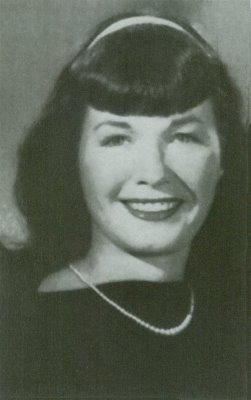
wrecking crew movie
A report released Thursday by leaders of the Senate Armed Services committee said that top Bush administration officials, including Donald H. Rumsfeld, the former defense secretary, bear major responsibility for the abuses committed by American troops in interrogations at Abu Ghraib prison in Iraq, Guantanamo Bay, Cuba, and other military detention centers.
[...]
The abuse of prisoners at Abu Ghraib, the report says, “was not simply the result of a few soldiers acting on their own” but grew out of interrogation policies approved by Mr. Rumsfeld and other top officials “conveyed the message that physical pressures and degradation were appropriate treatment for detainees.”
2 x 20' container con house
The auction of Redrock country will take place on December 19. At stake are world-renowned vistas near Canyonlands and Arches National Parks, as well as near Dinosaur National Monument. The highest bidders will earn the right to turn vast tracts of pristine wilderness into industrial wastelands.
It's bad enough that Bush officials went behind the backs of the American people with this disastrous scheme. But what's worse, they didn't even tell their own National Park Service until after the fact.
In my mind, this theft of our heritage goes beyond the cynical -- it's criminal. What will be left to give to our children and their children if we allow this administration, in a parting shot, to destroy our legacy of public lands for short-term gain?
I hope you're as angry as I am about this blatant land grab, because we've got to stop it -- and we have to act fast. The NRDC Action Fund is mobilizing more than one million Americans in an outpouring of protest over the coming days.
Send your own message of opposition immediately. Tell the Bush Administration that you will not allow it to destroy one of the most beautiful places on Earth.
Dennis Yost, the lead singer with the rock group the Classics IV, which in the late 1960s and early ’70s challenged the then-ascendant music of drugs and protest with a more laid-back, softer sound in Top 10 hits like “Spooky,” “Stormy” and “Traces of Love,” died on Sunday in Hamilton, Ohio. He was 65.
10 wall clocks
Although Polaroid says the film should be available into 2009, this is the final month of its last production year.
The appeal of regularly relocating where we live probably comes from our nomadic origins as a species, and over the years we’ve thrilled at the possibilities of some remarkable constructs designed to enable just that: the Icosa Pod, miniHome, Free Spirit Sphere, Nackros Villa, LoftCube, Trilobis, Kitahaus, and the relocatable sphere house. New Zealand is one of those countries where its near-to-no-one geographic location has created a hotbed of innovation through necessity and the Kiwi-produced Port-a-bach is particularly inventive because it is based around a remanufactured shipping container. As such, the NZD$100,000 (US$55,000) fold-out dwelling is not just rugged due to its natural steel exoskeleton, it’s as easy to transport internationally as it is to transport locally on a standard container truck. It has low environmental impact and can connect to local utilities or be entirely power, water and sewer independent.
the street corners of alphabet city
thx vz
The economic downturn has decimated the market for recycled materials like cardboard, plastic, newspaper and metals. Across the country, this junk is accumulating by the ton in the yards and warehouses of recycling contractors, which are unable to find buyers or are unwilling to sell at rock-bottom prices.
Ordinarily the material would be turned into products like car parts, book covers and boxes for electronics. But with the slump in the scrap market, a trickle is starting to head for landfills instead of a second life.
“It’s awful,” said Briana Sternberg, education and outreach coordinator for Sedona Recycles, a nonprofit group in Arizona that recently stopped taking certain types of cardboard, like old cereal, rice and pasta boxes. There is no market for these, and the organization’s quarter-acre yard is already packed fence to fence.
“Either it goes to landfill or it begins to cost us money,” Ms. Sternberg said.
rip studs terkel
Terkel was acclaimed for his efforts to preserve American oral history. His 1985 book The Good War, which detailed peoples' accounts of the country's involvement in World War II, won the Pulitzer Prize. For Hard Times: An Oral History of the Great Depression, Terkel assembled recollections of the Great Depression that spanned the socioeconomic spectrum, from Okies, through prison inmates, to the wealthy. His 1974 book, Working, in which (as reflected by its subtitle) People Talk About What They Do All Day and How They Feel About What They Do, also was highly acclaimed. Working was made into a short-lived Broadway show in 1978 and was telecast on PBS in 1982. In 1997, Terkel was elected a member of The American Academy of Arts and Letters. Two years later, he received the George Polk Career Award in 1999.thx stdpm and alex
judit bellostes excellent arch blog
regular angry mob or inside the beltway villagers?
via zoller
friends of loews jersey city
If you’re nodding in recognition, you’re a lucky owner of George Leonard Herter’s farrago “Bull Cook and Authentic Historical Recipes and Practices” — one of the greatest oddball masterpieces in this or any other language. A surly sage, gun-toting Minnesotan and All-American crank — the kind of guy who would take his own sandwiches to Disneyland because the restaurants were No Damned Good — Herter wrote books on such disparate topics as candy making, marriage advice, African safaris and household cleaning.via vz
Where could you find these books? Not in any fancy bookstore, friend. No, you needed a Herter’s sporting goods catalog. Starting in 1937 from atop his father’s dry-goods shop in Waseca, Minn., Herter over the next four decades built a mail-order sporting goods juggernaut. The arrival of the Herter’s catalog was like Christmas with bullets. Need a bird’s-eye maple gunstock? Check. How about a Herter’s Famous Raccoon Death Cry Call? Just two dollars. Fiberglass canoes? Got you covered. The catalog, which the former Waseca printer Wayne Brown recalls started as three-ring binder supplements, grew so popular — about 400,000 or 500,000 copies per run, he estimates — that Brown Printing became one of the country’s largest commercial printers.
atompunk
thanks lisa
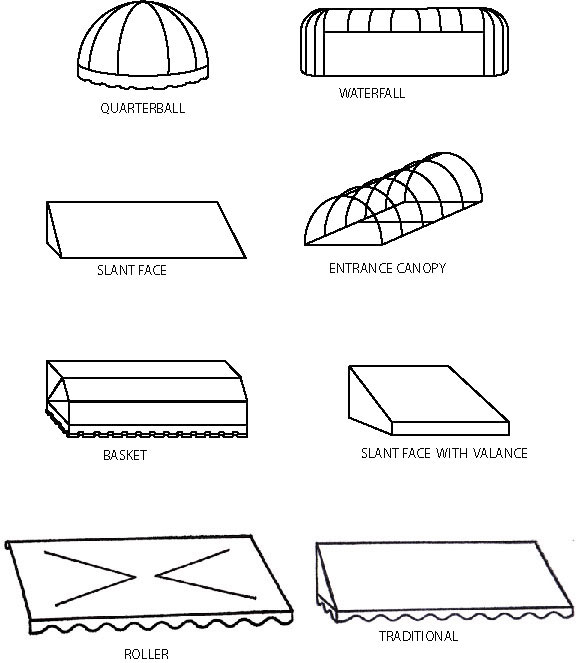
thanks tom
A7 NYHC reunion
The Peerless Tool Chest of H. O. Studley
thanks justin / more from wikipedia
The origin of the surf t-shirt, or "surfer t-shirt" if you prefer, can be traced back to Europe in the early 20th century. During World War I, U.S. soldiers noticed that European troops were wearing comfortable, lightweight cotton undershirts in the hot summer months. It didn't take long for the Americans--who were wearing heavy wool uniforms--to catch on. Because of the simple shape that resembles the letter "T", these undershirts soon became known to Americans as "t-shirts".surf links
At about this time surfing was enjoying its first renaissance in Hawaii. Surfing had been popular with Hawaiian natives until missionaries showed up in the mid-19th century. They disapproved of surfing and consequently, most natives had given it up by 1890. But thanks to guys like Duke Kahanamoku and other early surfers like George Freeth, the sport was re-born. We all know Duke as the father of modern surfing, and Freeth is credited with introducing the sport to Southern California in 1907
But the t-shirt was still considered underwear, and it took such Hollywood notables as James Dean, John Wayne and Marlon Brando to help change that. In 1951, Brando shocked moviegoers when his t-shirt was ripped off his chest in A Streetcar Named Desire. A few years later, the t-shirt became not only accepted as a stand alone outer garment, but actually very cool when James Dean starred in A Rebel Without A Cause.
In Matt Warshaw's Encyclopedia of Surfing credit is given to Gordon & Smith for having invented the surfer t-shirt. To promote his new brand of surfboards in 1961, Floyd Smith of Surfboards by Gordon and Smith invited local surfers to bring white t-shirts into his San Diego surf shop. There, he had the now-familiar Gordon and Smith logo screened on the t-shirt backs at no charge. Everyone owned several white t-shirts in the early '60s. The surf culture was gaining popularity and many wanted to be identified with it, whether they surfed or not..
danceteria club posters
via zoller
Bringing Brutal Back. Can restoring Paul Rudolph's signature building rescue the architect's reputation as well?
I forget just how I stumbled upon David Hoffman's 1962 film Bluegrass Roots, which was the first authoritative documentary on the subject. Top left is a segment of the doc, which features plenty of clogging (really! this style was called clogging!) and old timey playin'. The documentary gives a lot of weight to the elderly "Appalachian Minstrel", Bascom Lamar Lunsford, whom you'll see dancing with his wife about four and half minutes in. Lunsford had already been filmed about 30 years earlier, however, in a scene featured in The Times Ain't Like They Used To Be, a too-good-to-be-true folk video compilation with performances from 1928 to 1935. The DVD is in print but if, as with these depression era performers, hard times have got you in a squeeze, all the contents are on youtube. Top right is that clip of Lunsford's band with a cool introduction in which Lunsford hilariously obsesses about gettin' first prize in some music contest.
rip odetta
Her hope to sing at the Jan. 20 inauguration of President-elect Barack Obama had helped keep her alive for weeks when medical experts had despaired of her prospects for survival, Yeager said.
work chairs at workalicious
im talking to you dave.
The Empire State Building archive, which includes more than 500 items, is going on sale at the Wright auction house in Chicago on December 11. Wright’s low estimate for the collection, which includes elevation renderings, working drawings, models and maquettes, and other ephemera, is $470,000. The drawings of the building, arguably one of the most recognized in the world and the most loved in New York, had been stored at the homes of the last partners of the successor firm of Shreve Lamb & Harmon, the firm that designed the building. The office closed in 1995, having never surpassed the glory of the 1931 tower. The partners declined to be named.
In February 1958 they announced plans to re-establish the Irish Georgian Society, a group that had created a photographic record of Dublin’s best Georgian buildings earlier in the century; this new version, Mr. Guinness wrote in The Irish Times, would “fight for the protection of what is left of Georgian architecture in Ireland.” The following month they began restoring a building of their own, Leixlip Castle, a dilapidated 12th-century fortress on 182 acres west of Dublin, which would be their home and the group’s headquarters.
Now observing its 50th year with a series of celebrations and a lavishly illustrated book, the revived Irish Georgian Society has been credited with restoring dozens of architectural gems across Ireland, from a former union hall for Dublin tailors to the country’s oldest Palladian house. (The society’s early preservation efforts focused on Georgian Dublin, but in later years it expanded its mission to cover noteworthy buildings from any period.) Perhaps more impressively, the group has helped bring about a national change of heart regarding Irish architecture.
repurposing closed box-store boxes
Lu-Mi-Num company bikes of St. Louis
via zoller
A growing number of Steve McGreens are souping up their gas-electric hybrids to make them go faster and handle better, while delivering stellar fuel economy. It isn't just gearheads busting their knuckles, either. A lot of the hybrid hackers are tech geeks whose innovations may well appear in the cars we'll buy tomorrow.
"The gearhead of today has evolved. People today want performance and fuel economy," Paul Goldman, the 46-year-old CEO of the hot-rod hybrid shop Juiced Hybrid, tells Wired.com. He sells more than 500 items ranging from suspension kits and chassis stiffeners to body kits and floor mats. Most of his customers are "educated people who care about the environment" and modify their cars "because they're tech savvy, not necessarily because they're car savvy."
Coming in late on this discussion. Catherine Spaeth, please get over yourself. Three posts on your blog about this peccadillo you discovered and all your words here in Johnson’s comments are just too much. Publishing “the plagiarist’s” picture under the blog title “_____ the Plagiarist,” it’s just melodramatic overkill.
I’m not sure that what you’re griping about (and griping, and griping…) is even properly plagiarism. As you describe it, a blogger used some of your words but “sapped your writing of all its critical bite in order to provide comparatively glowing fodder.”
That’s two different issues. If he changed your meaning but attributed the words to you, that’s one thing. Using your words verbatim and passing them off as his is another. It seems like the sins somewhat cancel each other out. I’m sure you can lecture me endlessly about why this is not so.
Cribbing others’ prose is wrong. Unfortunately the Internet is still an intellectual Wild West, and people do all kinds of things on the fly that won’t live up to your ethical standards as a print writer. You are the schoolmaster insisting on decorum while others are ducking from the hail of bullets as the bad guys ride into town. Point out your grievance, move on. No one cares how important you think you are.
global warming swimming pool
more swiped net junk
via zoller
My original effort was an attempt to understand how Whistler’s vision of the Thames, which is mostly represented horizontally in his paintings, was translated into representations of the vertical reach of New York City. The darkness and mist that covers the bridges and the far shore of the Thames revealed to Whistler an abstract and elemental formal quality that was instrumental in making his art so revolutionary—a deliberate arrangement of colors and shapes on a flat surface. As soon as photographers began looking at the vertical geography of New York, they began to see ways they could capture the unusual forms by covering details in the same cloak of darkness.
Whistler wasn’t afraid to make enemies or to go to court (as in the famous lawsuit against John Ruskin) to demand that he be recognized as a revolutionary artist who had showed urban citizens something they had never seen before. He even compiled his rebuttals to his critics in a book called The Gentle Art of Making Enemies. His influence extended beyond the realm of the visual arts; for example, when Ezra Pound was trying to promote Imagism in London in the second decade of the twentieth century, he cited Whistler’s courageous artwork in support of his ideas. Returning to the visual arts, even so brash and semiabstract a painter as Joseph Stella, whose sharp angles seem distinct from Whistler’s delicacy of touch, also began his career as a maker of Whistleresque nocturnes.
It can be said that Whistler showed people how to paint a “moonlight” (his original term for what he later called nocturnes) without ever depicting the moon. This, coupled with the increasing ubiquity of artificial light, helped liberate the representation of night from a number of qualities that had become clichéd, most notably that it was a time of reflection and pastoral repose that would carry us back to childlike innocence.
But of course the book is not all about Whistler. The motif of the flaneur runs throughout. I try to show that Edgar Allan Poe had partly celebrated and partly parodied this figure in his story “The Man of the Crowd.” What he notices is that the flaneur can’t really make anything happen; his whole job is to observe and comment. But beginning in the late nineteenth century, the flaneur becomes an investigator. Think of Jacob Riis who was dedicated not just to observing the world but also to changing what he saw.
New Media vs Artists with Computers
Abigail Solomon Godeau
used wood burning stoves phil pa area
gloomy sunday

